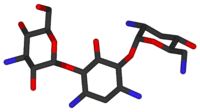Tobramycin
 | |
 | |
| Clinical data | |
|---|---|
| Trade names | Tobrex |
| AHFS/Drugs.com | Monograph |
| MedlinePlus | a682660 |
| Pregnancy category |
|
| Routes of administration | IV, IM, inhalation, ophthalmic |
| ATC code | J01GB01 (WHO) S01AA12 (WHO) |
| Pharmacokinetic data | |
| Protein binding | < 30% |
| Identifiers | |
| |
| CAS Number |
32986-56-4 |
| PubChem (CID) | 36294 |
| DrugBank |
DB00684 |
| ChemSpider |
33377 |
| UNII |
VZ8RRZ51VK |
| KEGG |
D00063 |
| ChEBI |
CHEBI:28864 |
| ChEMBL |
CHEMBL1747 |
| ECHA InfoCard | 100.046.642 |
| Chemical and physical data | |
| Formula | C18H37N5O9 |
| Molar mass | 467.515 g/mol |
| 3D model (Jmol) | Interactive image |
| |
| |
| (verify) | |
Tobramycin is an aminoglycoside antibiotic derived from Streptomyces tenebrarius and used to treat various types of bacterial infections, particularly Gram-negative infections. It is especially effective against species of Pseudomonas.[1]
Medical uses
Like all aminoglycosides, tobramycin does not pass the gastro-intestinal tract, so for systemic use it can only be given intravenously or intramuscularly. Ophthalmic (tobramycin only, Tobrex, or combined with dexamethasone, sold as TobraDex) and nebulised formulations both have low systemic absorption. The formulation for injection is branded Nebcin. The nebulised formulation (brand name Tobi) is indicated in the treatment of exacerbations of chronic infection with Pseudomonas aeruginosa in patients diagnosed with cystic fibrosis. A proprietary formulation of micronized, nebulized tobramycin has been tested as a treatment for bacterial sinusitis.[2] Tobrex is a 0.3% tobramycin sterile ophthalmic solution is produced by Bausch & Lomb Pharmaceuticals. Benzalkonium chloride 0.01% is added as a preservative. It is available by prescription only in the United States and Canada. In certain countries, such as Italy, it is available over the counter. Tobrex and TobraDex are indicated in the treatment of superficial infections of the eye, such as bacterial conjunctivitis. Tobramycin (injection) is also indicated for various severe or life-threatening gram-negative infections: meningitis in neonates, brucellosis, pelvic inflammatory disease, Yersinia pestis infection (plague). Tobramycin is preferred over gentamicin for Pseudomonas aeruginosa pneumonia due to better lung penetration..
Spectrum of susceptibility
Tobramycin has a narrow spectrum of activity and is active against Gram-negative bacteria. Clinically, tobramycin is frequently used to eliminate Pseudomonas aeruginosa in cystic fibrosis patients. The following represents MIC susceptibility data for a few strains of Pseudomonas aeruginosa:
- Pseudomonas aeruginosa - <0.25 µg/mL - 92 µg/mL [ref?]
- Pseudomonas aeruginosa (non-mucoid) - 0.5 µg/mL - >512 µg/mL [ref?]
- Pseudomonas aeruginosa (ATCC 27853) - 0.5 µg/mL - 2 µg/mL[3]
The MIC for Klebsiella pneumoniae, KP-1, is 2.3±0.2 µg/mL at 25 °C [unpublished].
It's not active against gram positive Bacteria except for Staphylococcus aureus.
Side effects
Like other aminoglycosides, tobramycin is ototoxic: it can cause hearing loss, or a loss of equilibrioception, or both in genetically susceptible individuals. These individuals carry a normally harmless genetic mutation that allows aminoglycosides such as tobramycin to affect cochlear cells. Aminoglycoside-induced ototoxicity is generally irreversible.
As with all amino glycosides, tobramycin is also nephrotoxic, it can damage or destroy the tissue of the kidneys [3]. This effect can be particularly worrisome when multiple doses accumulate over the course of a treatment or when the kidney concentrates urine by increasing tubular reabsorption during sleep. Adequate hydration may help prevent excess nephrotoxicity and subsequent loss of renal function. For these reasons parenteral tobramycin needs to be carefully dosed by body weight, and its serum concentration monitored. Tobramycin is thus said to be a drug with a narrow therapeutic index.
Mechanism of action
Tobramycin works by binding to a site on the bacterial 30S and 50S ribosome, preventing formation of the 70S complex. As a result, mRNA cannot be translated into protein, and cell death ensues. According to Kotra, Haddad and collaborators "aminoglycosides, including Tobramycin, are multifunctional hydrophilic sugars that possess several amino and hydroxy functionalities. The amine moieties are mostly protonated in biological media; hence, these antibiotics can be considered polycationic species for the purpose of understanding their biological interactions. Since they are polycationic, they show a binding affinity for nucleic acids. Specifically, aminoglycosides possess high affinities for certain portions of RNAs, especially the prokaryotic rRNA. In addition, aminoglycosides bind to the hammerhead ribozyme, tRNA(Phe), the Rev response element (RRE) transcriptional activation region in human immunodeficiency virus (HIV), the ribozyme from hepatitis delta virus, and group I self-splicing introns.[4]"
References
- ↑ "Tobramycin" (pdf). Toku-E. 2010-01-12. Retrieved 2012-06-11.
- ↑ "Nebulized Tobramycin in treating bacterial Sinusitis" (Press release). July 22, 2008. Retrieved 2009-12-06.
- ↑ http://www.toku-e.com/Assets/MIC/Tobramycin.pdf
3. Davis, Bernard D. "Mechanism of bactericidal action of aminoglycosides." Microbiological reviews 51.3 (1987): 341.
4. Kotra, Lakshmi P., Jalal Haddad, and Shahriar Mobashery. "Aminoglycosides: perspectives on mechanisms of action and resistance and strategies to counter resistance." Antimicrobial agents and chemotherapy 44.12 (2000): 3249-3256.